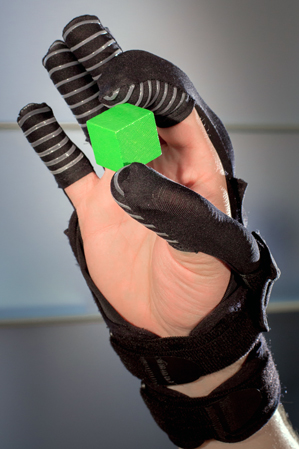Engineers at Harvard University have developed a soft robotic glove that grants individuals with limited hand mobility the ability to grip and pick up objects. This glove could help an estimated 6.8 million people in the United States with hand mobility issues, such as those with a progressive disability, stroke, or old age.
 There are so many tasks often taken for granted by individuals without disabilities (e.g. buttoning a shirt, using eating utensils, picking up a telephone etc.). Meanwhile, for most persons with muscular dystrophy, amyotrophic lateral sclerosis (ALS), and other conditions, these “simple” activities are anything but simple. The engineers hope to someday help affected individuals regain independence with this new robotic glove, and ultimately improve their quality of life.
There are so many tasks often taken for granted by individuals without disabilities (e.g. buttoning a shirt, using eating utensils, picking up a telephone etc.). Meanwhile, for most persons with muscular dystrophy, amyotrophic lateral sclerosis (ALS), and other conditions, these “simple” activities are anything but simple. The engineers hope to someday help affected individuals regain independence with this new robotic glove, and ultimately improve their quality of life.
The glove has been engineered by Conor Walsh and his team of engineers. Walsh is an assistant professor of mechanical and biomedical engineering and founder of the Harvard Biodesign Lab at SEAS, and is a core staff member at the Wyss Institute.
“From the start of this project, we’ve focused on understanding the real-world challenges facing these patients by visiting them in their homes to perform research,” said Walsh. The holistic approach Walsh and his team are taking ensures that “technology development goes beyond simple functionality to incorporate social and psychological elements of design that promote seamless adoption by its end users.”
To maximize the glove’s potential for all users, the team has incorporated patient feedback at every stage of development. So far, nine individuals with muscular dystrophy, ALS, incomplete spinal cord injuries, or complications from a stroke have tested the glove so far.
This robotic glove is mechanically programmed to execute a single task, performed with a bending motion of the fingers and a bending and twisting movement of the thumb. This MIT review continues explaining:
The fingers are essentially silicone balloons–pink, rubbery things–with yellow fibers crisscrossed inside. When pressurized water is pumped into the glove from an attached waist pack, the fibers keep the balloon from expanding, so their arrangement programs the finger to bend in a particular way. For example, there are fewer fibers at the knuckles, which induces the finger to bend there.
There are already existing robots with hard exoskeletons which serve as assistive devices guiding patients through rehab exercises. However, the soft glove “aligns more flexibly with a patient’s joints, plays nice with soft tissue like human skin, and, since it is much lighter, could eventually be taken home instead of being limited to use in a clinic.”
To learn more about this project, be sure to check out the full article on the Harvard Gazette.

how much are these soft robotic gloves?
It looks like it is still in development: https://wyss.harvard.edu/technology/soft-robotic-glove/
One of my cousins, Danny Don Kitten, has limited feeling in his thumbs from Cerebal Pulsey, a birth defect. So he drops things because of no feeling. What do you recommend for a glove to help grasp? Jerry Kitten 806-773-2262 cell/text,
jerryjkitten@gmail.com
Hello – I have ALS and came across this article about a robotic glove. Has this progressed she is it available?
Thank you.